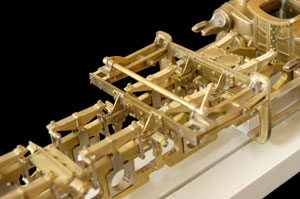
The driver springs, hangers and equalization system are almost complete as shown here. I build the valve gear hanger next. Almost all the parts were scratch built from brass. I drew the individual pieces in a 3d modeling program called ProEngineer and then ran them through the "Rapid Prototyping" process. My firm has a Sanders "wax printer" that makes patterns that I can investment cast in brass. The process still needs a lot of hand work in polishing and fitting, but, I suppose that it does save a little time over machining each part. The reversing bar and levers were silver soldered together for extra strength. Again, many scale simulated bolts and studs with nuts were used.
I wanted the trailing truck to be as faithful a reproduction of the original as I could stand. While I was able to use a few pieces from the Kelley Morris Ps4 castings, most had to be scratchbuilt. The photo the assembly with only the left side completed. The extension itself was cnc machined on my MaxNC as were the links and equalizing arms. I simulated the action of the ridged leaf springs by installing extension springs hidden in the frame. The tires were machined from steel to NMRA Proto32 finescale standards which duplicate the prototype exactly. Currently, I am using the Ps4 rear truck brace, but, I intend to make the version used on the USRA Mikados as soon as get the inspiration.
This is a great example of the PRR making these "non-PRR" engines feel more at home. The shops removed almost everything but the pilot beam. Then they installed the standard PRR freight loco pilot pieces. This included footboards, cut lever with PRR pilot brackets, lantern brackets and the classic PRR style "helmet" marker lights. I was lucky enough to have a nearly complete set of PRR drawings for these pieces so I made them as faithful to the drawings as possible. Naturally, almost everything is made from scratch.
Only the outer bolt pattern keeps its USRA identity. You have to wonder why the PRR replaced this piece. In the model, the front consists of three main parts - the flat outer rim, the "domed" inner piece, and the door. The outer rim was cnc machined on the MaxNC mill and all the holes drilled in the same setup. Care was taken to simulate the 1/4" thick steel plate used on the original smokebox front. The inner rim was cast and soldered to the outer rim. The solder fillet was carefully dressed to simulate the 1/4" radius of the original stamping. Each door dog was made and installed separately. The door was also cast and the hinges were fabricated. If you look carefully, you can see beginnings of the two step brackets bolted on the outer bolt circle. Simulated nuts and studs were soldered in this bolt circle and the studs lightly filed down to approximate the "peened over" studs on the original. Since this photo was taken, I have fabricated the standard PRR headlight bracket. Like the B6 switcher family, the L2s had the bracket sides at an angle rather than straight down. I will show you this for the next update. maybe I will have put the handrail and brackets on as well.
I see that I have completely ignored the cylinders. Maybe I'll describe them next time.